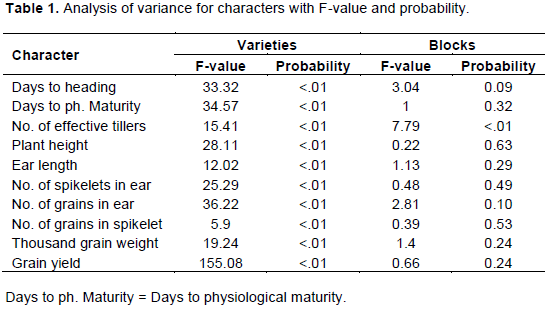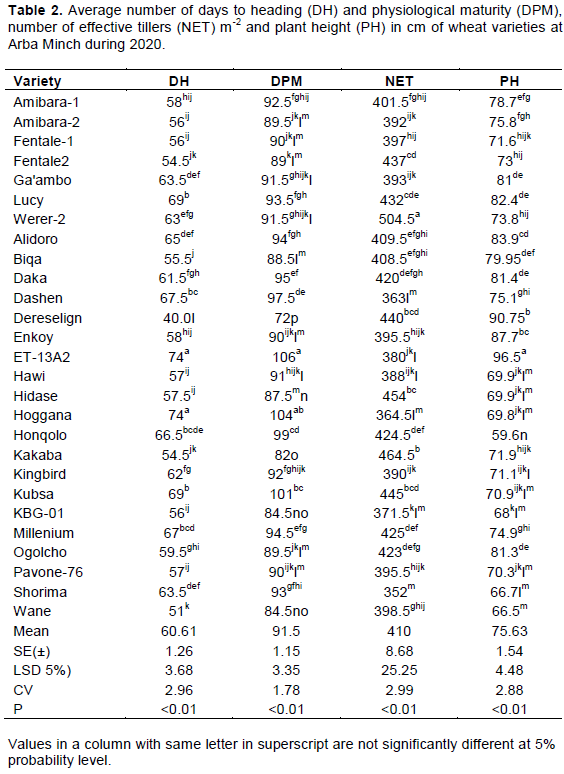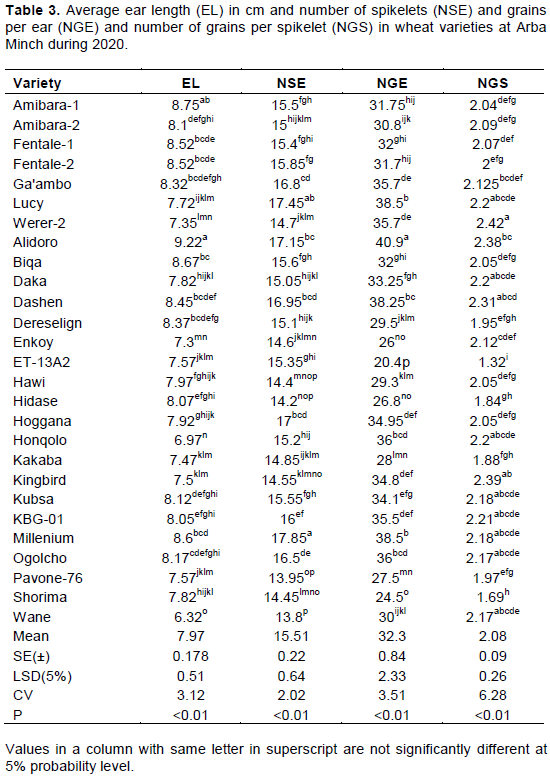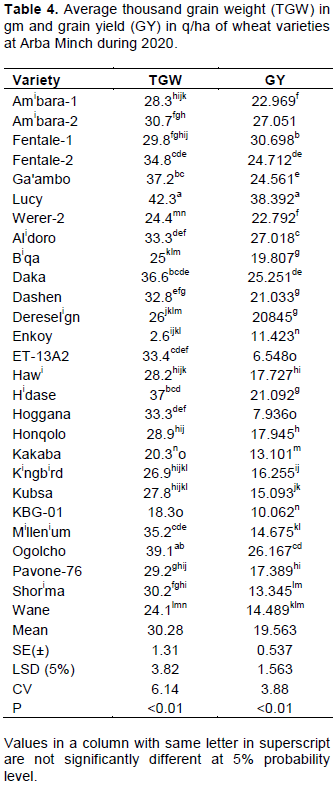The objective of this research was to evaluate wheat genotypes for yield and yield characteristics under the low land area of Arba Minch, Southern Ethiopia. A field experiment was conducted with 27 bread wheat genotypes in a randomized complete block design with two replications at Amibara Farm, Arba Minch from March to June 2020. Varieties differed significantly (p<0.01) for the yield related characters and yield. The major findings include identification of varieties with earliest heading and physiological maturity, highest number of effective tillers formed, ear length and spikelets in the ear, grains in ear and spikelet, thousand grains weight, and grain yield. It could be concluded that varieties, Lucy, Fentale-1, Amibara-2, Alidoro, Ogolcha, Daka, Fentale-2, Ga’ambo, Amibara-1 and Werer-2 were high yielding under lowland area at Arba Minch. It is recommended that these varieties should be further tested for identification and selection of high yielding ones for lowland areas in Southern Ethiopia.
Wheat (Triticum aestivum L.) is the most important cereal crop of the family Poaceae (Gramineae) and is the second most important staple food crop after rice grown in 89 countries comprising temperate, subtropical and tropical climates. It was cultivated in more than 221 million hectares of land producing 728.9 million tonnes of food grains with a productivity of 36.2 q/ha in the world (FAO, 2014). It is the staple food of about 35 percent of the world’s population (Nanda and Agrawal, 2008). Bread wheat (T. aestivum L.) grain contains gluten protein which makes it suitable to prepare leavened bread, pita bread, chapati, Naan, ambassa, cake and other food recipes. It is an important source of carbohydrates (68%), proteins (13%), minerals, and vitamin B and E. It provides 19% of the total calories in human food in the world, which is higher than other food sources (FAO, 2014). It is also used as animal feed and its straw as fodder for cattle, house thatching, manufacturing paper, cardboard, and several handicraft items.
Ethiopia ranks first in wheat production followed by Sudan and Kenya in East Africa, and second in sub- Saharan Africa after South Africa (FAO, 2015). It is the third largest produced cereal crop after maize and teff (Eragrostis tef) in Ethiopia. Wheat is grown >1500 m.a.s.l. in mid and highland areas as a rain-fed crop in Ethiopia. Irrigation contributes 1.1% of the total cultivated land (Girmay, 2017). At mid and highlands between1900 m.a.s.l. and 2700 m.a.s.l., wheat was grown in 1.696907 million hectares during 2017-18 and produced about 46.429657 million tonnes with average productivity of 27.3 q/ha in Ethiopia (Anonymous, 2018); whereas the world average productivity was 33 q/ha (EIAR, 2020). Bread wheat demand in Ethiopia is increasing because of the preference of people to use it for food as a major source of energy and protein (Hailu, 2003) and it accounts for about 65% of the total wheat area (Alemayehu et al., 2011). The remaining area is under durum and emmer (Aja) wheats. There is a shortage of wheat production in the country for meeting the demand. According to Gebre et al. (2017), about 1.0 million tons of wheat is being imported annually since 2008 in Ethiopia at the cost of 500 million US dollars. Lately, Ethiopia imported 1.7 million tonnes of wheat (EIAR, 2020).
Wheat production can be scaled up by developing short duration, heat and stress tolerant varieties under lowland areas (< 1500 m). Studies conducted at Werer Agricultural Research Centre of the Ethiopian Institute of Agricultural Research (EIAR) had indicated that wheat grain yield of above 40.0 q/ ha could be obtained in lowland irrigated areas (Mohammad, 1994). Wheat production has to be increased by expanding the cultivation of wheat in low land areas with high temperatures and different types of soils (Bayisa et al., 2019). There are prospects of wheat production in irrigated lowland around lakes, Abaya and Chamo at Arba Minch and Omo river valley, Southern Ethiopia and 12 river basins in Ethiopia (Amanuel et al., 2018). Information based on studies to evaluate wheat genotypes in lowland areas in Southern Ethiopia is lacking. The present investigation was undertaken with the objective of evaluating bread wheat genotypes for yield and yield characteristics under lowland irrigated areas at Arba Minch, Southern Ethiopia.
Description of the study area
Study area is located at 6°3’37 N latitude, 37°33’ E longitude and is low land at 1202 m elevation above mean sea level at Amibara Farm, Arba Minch irrigated from Kulfo River water. The experimental field was nearly level with 0.5 to 2% slope and 0.3 to 1.1 degrees. Soil characteristics of the field were determined from a composite sample made by mixing 5 random soil samples drawn from 0 to 15 cm depth following standard procedures. The proportions of sand, silt and clay particle sizes in the soil were 9, 39 and 52%, respectively with overall textural class as clay. The pH of the soil was neutral (6.8). The organic matter (OM) and total nitrogen (TN) contents were 1.93 and 0.09%, considered as low and medium, respectively (Tekalign, 1991). The carbon nitrogen ratio (C/N) of 12 was fairly good. The available phosphorus (P) and potassium (K) were 34.2 and 269 ppm, and are considered as very high (Olsen et al., 1954). The cation exchange capacity (CEC) of 56.86 centimol per kg was very high (>40). The concentration of exchangeable cations, Ca, Mg, Na, and K being 40.23, 8.27, 0.44 and 0.93 centimol per kg, respectively; and the cation exchange capacity (CEC) of 56.86 Centimol per kg were very high. The overall base saturation (BS) of 88% was very high (>80) according to Hazelton and Murphy (2007). Based on OM and TN contents, the soil appeared to be not adequately fertile. However, other parameters, C/N ratio, available P and K, exchangeable bases, CEC and BS indicated that the soil was fertile.
Weather conditions during the study
The mean monthly maximum temperatures during March, April, May and June, the wheat cropping period were 33.16, 31.31, 31.05 and 30.24°C. The mean minimum temperatures during these months were 18.18, 17.84, 18.54 and 17.86°C. The total rainfall during March, April, May and June was 167.5mm, 263.2, 127.1 and 82.5mm, respectively; but it was not evenly distributed. The mean monthly relative humidity percent during March, April, May and June was 57.20, 65.04, 64.53 and 63.85 percent, respectively. The mean sunshine hours during March, April, May and June were 8.61, 6.2, 7.06 and 6.2 h, which were fairly adequate for the growth of wheat crop.
Materials and experimental design
The materials for the study consisted of 27 wheat genotypes/varieties, namely, Amibara-1, Amibara-2, Fentale-1, Fentale-2, Ga’ambo, Lucy, Werer-2, Alidoro, Biqa, Daka, Dashen, Dereselign, Enkoy, ET 13A2, Hawi, Hidase, Hoggana, Honqolo, Kakaba, Kingbird, Kubsa, KBG-01, Millenium, Ogolcho Pavone-76, Shorima and Wane. The seeds of the varieties were collected from Agricultural Research Centers (ARC) at Werer and Kulumsa of the Ethiopian Institute of Agricultural Research in February 2020. The field experiment with 27 genotypes/treatments was laid out in a randomized complete block design with two blocks/replications with a seed rate of about 100 kg/ha. The plot size for each treatment was 6 rows of 3 m, with space between rows of 30 cm.
Experimental procedure
Field preparation
The field was ploughed by tractor and left for drying for 15 days in February followed by harrowing/disking 3 times and ditching for making water channels. Pre-sown irrigation was given for preparation of the field with adequate moisture.
Fertilizers and chemicals application
Blended fertilizer, NPSB (18.9% N:37.7 % P2O5: 6.97% S: 0.1% B) was applied at 150 kg per hectare as basal dose and Urea (46%N) at 150 kg per hectare in two split doses at tillering and shooting stages as per fertilizer recommendation for wheat production under low land in Ethiopia (Anonymous, 2015). The total nutrients applied through fertilizers were 97.35 kg/ha N, 56. 55 kg/P2O5, 10.45kg/ha S and 0.15 kg B. The fungicides, “Progress- Propiconazole” and “Nativo-Trifloxystrobin+ Tebuconazole” were sprayed at 0.5 and 1.0 l/ha on wheat crop at tillering and heading stages to control leaf rust disease. The insecticides, “Ferrate” and “Diazinone” were sprayed at 0.5 and 1.0 l/ha at heading and grain development stages to control stem borer and termites.
Irrigations and weeding
Besides the receipt of irregular uneven distributed total rainfall of 621.3 mm during the wheat crop period from March to June 21, 2020, when the soil of the experimental field was dry, four supplementary irrigations were given with flowing water at the coronal/nodal root initiation stage on March 28, tillering stage on April 10, shooting/ heading stage on May 15 and grain development stage on May 21, 2020. Weeding, hoeing and tying of wheat plants were done manually when required beginning from germination to the harvesting of the crop in June 2020.
Data collection
Data were collected on 9 yield-related characters and the grain yield, namely, days to 50% heading or spike emergence and days to 90% physiological maturity from the sowing date, plant height (cm) on ten random plants, number of effective or productive tillers per square meter in net plot, ear/spike length (cm) on ten random plants per plot, number of spikelet in ear/spike and number of grains per ear and per spikelet on ten random plants, and thousand grains weight (g) and grain yield (g) adjusted to 12.5 % moisture content per plot and converted to quintal per hectare (q/ha).
Data analysis
Data were subjected to analysis of variance for the characters in randomized complete block design following SAS – Version 9.00 (2004). Means were compared with least significant difference at 5% level of probability.
The results on yield characteristics and yield of wheat varieties at Arba Minch 2020 are presented in the following sections. The analysis of variance for the characters with F-value and probability is presented in Table 1.
Days to heading
Varieties differed significantly (p<0.01) for the number of days to heading (DH) or spike emergence which varied from 40 to 74 days with the mean of all varieties 60.61 DH (Table 2). The earliest heading was recorded in 40 days in variety Dereselign, which was significantly different from other varieties. The second earliest heading occurred in 51 days in variety Wane, which also differed from other varieties. The next earlier heading varieties were Fentale-2, Kakaba, Biqa, Amibara-1, Fentale-1, Hawi, Hidase, KBG-01, Pavone-76, Amibara-1, Enkoy, and Ogolcho (54.5 to 59.5 DH). Varieties taking more days to heading than the mean of all varieties were Daka, Kingbird, Ga’ambo, Alidoro, Shorima, Werer-2 and Honqolo. The late heading varieties were Millenium, Dashen, Lucy and Kubsa with the latest ones, ET-13 A2 and Hoggana, taking 74 days. As in the present studies, significant differences among genotypes for DH were recorded at Werer Agricultural Research Centre (WARC) under low land irrigated conditions (Gebre et al., 2017; Bayisa et al., 2019). In comparison, variety Werer took 5 more days (63DH) at Arba Minch than that at Werer (Bayisa et al., 2019). The early heading at WARC could be due to higher monthly maximum and minimum temperature (38.06 and 21.06°C) than at Arba Minch (31.44 and 18.10°C) during the crop season. Early heading in wheat varieties had also been observed under drought and heat stress than irrigated conditions in Nepal (Poudel et al., 2020).
Days to physiological maturity
Varieties differed significantly (p<0.01) for number of days to physiological maturity (DPM) ranging from 72 to 106 days with mean of all varieties 91.5 DPM (Table 2). Variety Dereselign was earliest to physiologically mature at 72 days changing colour of leaves, peduncles and ears/spikes from green to yellow of 90% of the plants from the sowing. At this stage, the grains are fully de- veloped and lose connection for the supply of photosynthetic assimilates, nutrients and water from the tissues of the ovary of the mother plants. The other earlier maturing varieties were Kakaba, KBG-01 and Wane taking 82-85 days. The next early maturing varieties were Hidase, Biqa, Fentale-2, Amibara-2, Ogolcho, Fentale-1, Pavone-76 and Enkoy, which took 88 to 90 days. Varieties with mid maturity period (91-93days) around the mean of all varieties were Hawi, Ga’ambo, Werer-2, Kingbird, Amibara-1, Shorima, Lucy, Alidoro, Millenium and Daka. The late maturing varieties were Dashen, Honqolo, Kubsa and Hoggana along with latest maturity in variety, ET-13A2 (106 DPM). As in the present studies, significant differences for days to physiological maturity among genotypes were found at WARC (Gebre et al., 2017; Bayisa et al., 2019). Varieties, Fentale and Werer matured 8 days later at Arba Minch than that at WARC. It could plausibly be due to about 7 and 3°C less mean maximum and minimum monthly temperatures (31.44 and 18.1°C) at Arba Minch than that at Werer (38.06 and 21.06°C) during the cropping season. It is known that lower temperatures delay growth and maturity in plant species and thus the difference in days to maturity of varieties at Arba Minch and Werer in Ethiopia. Similarly, wheat varieties matured late in irrigated conditions than that in drought and heat stress environments in Nepal (Poudel et al., 2020).


Number of effective tillers
Average numbers of effective or productive tillers per m2 in wheat varieties are presented in Table 2, which varied from 504.5 to 352 m-2 with the mean of all varieties 410 m-2. Varieties differed significantly (p<0.01) for number of productive tillers per m2. Highest number of effective tillers (504.5 m-2) was produced in variety Werer-2. The second highest tillers were formed in variety Kakaba (464.5 m-2) followed by varieties Hidase, Kubsa, Dereselign, Fentale-2 and Lucy. The third group of varieties producing high effective tillers (425to 401.5 m-2) were Millenium, Honqolo, Ogolcho, Daka, Alidoro, Biqa and Amibara-1. Other varieties forming productive tillers less than the mean of varieties were Wane, Fentale-1, Enkoy, Pavone-76, Ga’ambo, Amibara-2, Kingbird, Hawi and ET-13A2. The lower effective tillers were formed in varieties KBG-01, Hoggana and Dashen with lowest in Shorima (352 m-2). In line with the present studies, significant differences among genotypes/varieties for number of effective tillers were reported by other researchers (Raza et al., 2018; Bayisa et al., 2019).
Plant height
Varieties differed significantly (p<0.01) for plant height, which varied from 59.6 to 96.5 cm (Table 2). Highest plant height (96.5cm) was recorded in variety ET-13 A2. The next higher plant height was in varieties Dereselign and Enkoy. These three wheat varieties with plant height range between 86 cm and 100 cm could be categorized as a double dwarf. The plants of variety, Enkoy, with an average height of 87.7 cm lodged affecting its yield. Wheat genotypes/varieties with plant height between 101-and 115 cm are categorized as a single dwarf (Ram, 2011). The plant height in the remaining 24 varieties was less than 85 cm (Ram, 2011).
There were significant differences among the triple dwarf varieties. Varieties Alidoro, Lucy, Daka, Ga’ambo, Ogolcho, Biqa and Amibara-2 had higher plant height (83.9 -78.7 cm). The other triple dwarf varieties with plant height around and less than the general mean were Amibara-2, Dashen, Millenium, Werer-2, Fentale-2, Kakaba and Fentale-1. The shorter plant height from 71.1 to 66.5 cm was recorded in varieties Kingbird, Kubsa, Pavone-76, Hawi, Hidase, Hoggana, KBG-01, Shorima and Wane, with the shortest plant height of 59.6 cm in variety Honqolo. As in this study, significant differences among genotypes/ varieties were found at WARC (Gebre et al., 2017; Bayisa et al., 2019). However, it may be mentioned that the plant height in varieties Werer, Amibara, Fentale and Amibara at Arba Minch was 11 to 21 cm more than that at WARC (Bayisa et al., 2019), which could plausibly be due to more time taken by these varieties at Arba Minch for growth and maturity.
Ear length
Varieties differed significantly (p<0.01) for ear or spike length which varied from 9.22 to 6.32 cm with mean of all varieties 7.97 cm (Table 3). Longest ear length (9.22 cm) was recorded in variety Alidoro, which was statistically on par with Amibara-1. Other varieties with longer ears were Biqa, Millenium, Fentale-1 Fentale-2, Dashen, Dereselign, Ga’ambo and Ogolcho (8.67 cm to 8.17 cm). Medium ear length was recorded in varieties Kubsa, Amibara-2, Hidase, KBG-01, Hawi, Hoggana, Daka, Shorima and Lucy (8.12 cm to 7.72 cm). Short ears were formed in varieties ET-13A2, Pavone-76, Kingbird, Kakaba, Werer-2 and Enkoy (7.57 to 7.30 cm). Shorter ears were produced in variety Honqolo (6.97 cm) and the shortest ears in variety Wane (6.32 cm). As in the present study, significant differences among genotypes for spike or ear length were reported by other researchers (Gebre et al., 2017; Bayisa et al., 2019).
Number of spikelets in ear
Varieties differed significantly (p<0.01) for number of spikelets in ear or spike, which varied from 17.85 to 13.8 with mean of all varieties 15.51 (Table 3). Highest spikelets in ear (17.85) were formed in variety Millenium, followed by variety Lucy. The next higher spikelets in ear were produced in varieties Alidoro, Hoggana, Dashen and Ga’mbo, followed by Ogolcho and KBG-01 (17.15 to 16). The high number of spikelets was recorded in varieties Fentale-2, Biqa, Kubsa, Amibara-1, Fentale-1 and ET-13A2 (15.88 to 15.35). Small number of spikelets in ear was noted in varieties Honqolo, Dereselign, Daka, Amibara-2, Kakaba, Werer-2 and Enkoy (15.2 to 14.6). Further lower spikelets in ear were recorded in varieties Kingbird, Shorima, Hawi, and Hidase; and the lowest in varieties Pavone-76 and Wane (13.95 and 13.8). As in the present studies, significant differences among genotypes for number of spikelets per ear were also reported by others (Gebre et al., 2017; Bayisa et al., 2019).

Number of grains in ear
Varieties differed significantly (p<0.01) for number of grains in the ear which varied from 40.9 to 20.4 grains with mean for all varieties 32.33 grains (Table 3). Highest number of grains in the ear was formed in variety Alidoro. Second higher grains in the ear were recorded in varieties Lucy, Millenium and Dashen (38.5 to 38.25). The next high grains in the ear were produced in varieties Honqolo, Ogolcho, Ga’ambo, Werer-2, KBG-01, Hoggana, Kingbird and Kubsa (36 to 34.1). Medium number of grains in ears around the general mean was formed in varieties Daka, Fentale-1, Biqa, Amibara-1, Fentale-2, Amibara-2 and Wane. Low grains in ear were found in varieties Dereselign, Hawi, Kakaba, and Pavone-76. Lower grains in the ear were recorded in varieties Hidase, Enkoy and Shorima; and the lowest grains in variety ET-13A2 (20.4 grains). As in the present set of varieties, the significant differences among genotypes for grain number per spike were reported by other researchers (Gebre et al., 2017; Bayisa et al., 2019).
Number of grains in spikelet
Varieties differed significantly (p<0.01) for number of grains in spikelet which varied from 2.42 to 1.32 with mean of all varieties 2.08 (Table 3). Highest number of grains per spikelet (2.42) was formed in variety Werer-2, which was statistically on par with varieties Kingbird, Alidoro, Dashen, KBG-01, Lucy, Daka, Honqolo, Kubsa, Millenium, Ogolcho and Wane (2.39 to 2.17). The low grains in spikelet were recorded in varieties Ga’ambo, Enkoy, Amibara-2, Fentale-1, Biqa, Hawi, Hoggana, Amibara-1, Fentale-2, Pavone-76, Dereselign and Kakaba (2.12 to 1.88). The lower grains in spikelet were recorded in varieties Hidase and Shorima, and the lowest in variety ET-13A2 (1.32 grains). As in the present study, the differences among genotypes for number of grains in spikelets have been reported by other researchers (Raza et al., 2018; Amanuel et al., 2018).
Thousand grains weight
Varieties differed significantly (p<0.01) for thousand grains weight which varied from 42.3 to 18.3 g with mean of all varieties 30.28 g (Table 4). Maximum grain weight (42.3 g) was found in variety, Lucy which was statistically on par with variety Ogolcho (39.1 g). The second high thousand grains weight was recorded in varieties Ga’ambo, Hidase, Daka, Millenium, Fentale-2 and ET-13 A2 (37.2 to 33.4 g). The medium thousand grains weight was found in varieties Alidoro, Hoggana, Dashen, Amibara-2, Shorima and Fentale-1 ((33.3 to 29.8 g). Low thousand grain weight was noted in varieties Pavone-76, Honqolo, Amibara-1, Hawi, Kubsa, Kingbird, Enkoy, Dereselign and Biqa (29.2g to 25g). Further, lower thousand grains weight was observed in varieties Wane, Werer-2 and Kakaba (24.1 to 20.3 g), with the lowest being in variety KBG-01 (18.3 g). As in the present investigation, significant differences among genotypes for thousand kernels or grain weights were reported by other researchers (Gebre et al., 2017; Raza et al., 2018; Amanuel et al., 2018; Bayisa et al., 2019; Mekonnen et al., 2019; Poudel et al., 2020).

Grain yield
Varieties differed significantly (p<0.01) for grain yield, which varied from 38.393 q/ha to 6.548 q/ha with mean of all varieties 19.563 q/ha (Table 4). Highest grain yield (38.392 q/ha) was recorded in variety, Lucy. The second highest grain yields were obtained in varieties Fentale-1, Amibara-2, Alidoro, Ogolcha, Daka, Fentale-2 and Ga’ambo (30.698 q/ha to 24.561 q/ha). The next high grain yields were found in varieties Amibara-1 and Werer-2 (22.969 to 22.792 q /ha) followed by varieties Hidase, Dashen, Dereselign and Biqa (21.092 to 19.807 q/ha). The remaining 13 varieties had lower grain yields than the mean of all varieties (19.563 q/ha). However, there were also significant differences among the low grain yielding varieties. These varieties in descending order of grain yields were as follows: Honquolo (17.945 q/ha), Hawi, Pavone-76, Kingbird, Kubsa (15.093 q/ha), Kakaba (13.101 q/ha), Enkoy, KBG-01(10.067 q/ha), Hoggana (7.936 q/ha) and ET-13A2 (6.548 q/ha). Thus, there was much genetic variation in grain yield potential of the varieties evaluated in the present investigation. As in the present studies, significant differences among genotypes/varieties for grain yield were reported by other researchers (Gebre et al., 2017; Amanuel et al., 2018; Gebreegzibher et al., 2018; Bayisa et al., 2019; Mekonnen et al., 2019). The comparison of yields of varieties indicated that varieties, Fentale and Amibara gave 7 and 15 q/ha more yield at Arba Minch than at Were Agricultural Research Centre (WARC) but the yield of variety Werer matched with that at WARC (Bayisa et al.,2019). Increase of yield in the former varieties could be ascribed to late maturity at Arba Minch because of 3°C lower minimum temperature (18°C) at Arba Minch than at Werer (21°C). It is in line with the conclusion drawn on reviewing the effect of heat stress on wheat that for each °C increase in minimum temperature or the night temperature, the wheat yield would reduce by 6 per cent (Akter and RafiqulIslam, 2017). Variety Ga’ambo gave better yield at three low land areas in Afar district (Amanuel et al., 2018; Gebreegzibher et al., 2018) than at Arba Minch. However, the yields of varieties, Fentale, Amibara and Werer were in the same order and matched with that at Tendaho and Arba Minch, Tendaho is located in the north eastern warm Afar region (Gebreegziabhe et al., 2018), whereas Arba Minch is located in warm Southern region of Ethiopia. It is indicated that the yield varied with the genotypes and the environment. The yield could also be influenced by the genotypes by environment (G x E) interaction (Mekonnen et al., 2019, Amanuel et al., 2018; Bayisa et al., 2019; Poudel et al., 2020). The minimum and maximum temperatures, soil types and pH, relative humidity and incidence of leaf rust disease at the locations could affect the performance of varieties. However, the grain yield contributed by several characters was primarily a genotypic characteristic, but it could be influenced by environment and genotype by environment (G x E) interaction. Hence, varieties suitable for specific area adaptation and for wide adaptation could be selected by testing the performance over multiple location environments. This strategy in wheat and other crops breeding has led to selection of improved varieties with high yields adaptable to different environments. Thus, wheat varieties suitable for low land can be selected by evaluation of performance under low land areas (Gebre et al., 2017).